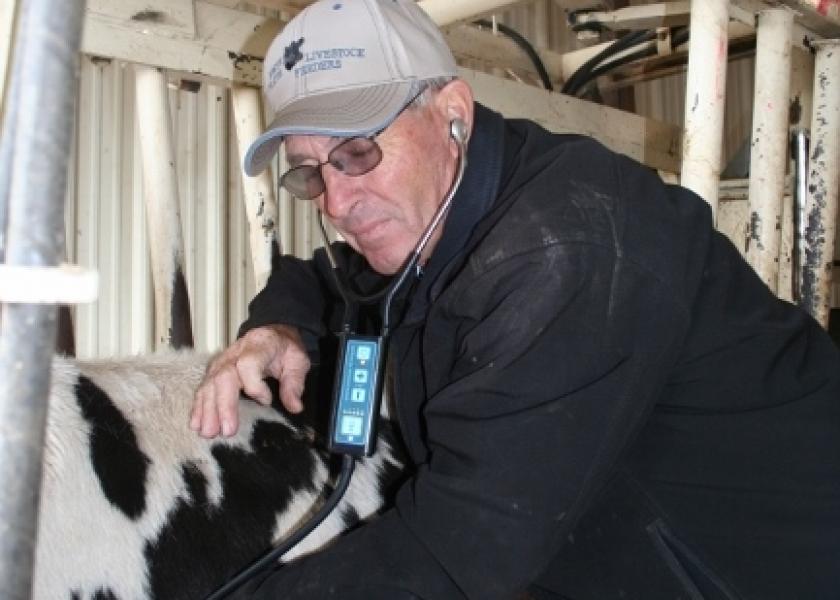Whisper Makes Noise

Editor’s note: We’ll have a series of articles summarizing highlights from the recent Bovine Respiratory Disease Symposium and Academy of Veterinary Consultants Conference on this site over the rest of this month. Check back often.
The Whisper digital auscultation (stethoscope) system, introduced in 2014, initially found use in feedlot hospitals, as a tool for assessing severity of respiratory cases and helping guide treatment decisions. Since then, Merck Animal Health purchased the technology from Geissler Corporation and has invested heavily in refining the system and expanding its capabilities.
During the recent Academy of Veterinary Consultants Conference in Denver, Merck technical services veterinarian Dr. Jason Nickell summarized results of several trials using the next-generation Whisper system as a tool for improving health outcomes while reducing mass-treatment expenses for high risk cattle upon arrival in stocker or finishing operations. His presentation was titled “Precision Antimicrobial Protocols: Using Whisper On-Arrival Technology to Make Objective and Individualized Metaphylactic Decisions.”
Research and field experience have consistently shown that metaphylaxis using antibiotics with high-risk calves upon arrival pays off with lower morbidity, lower treatment costs and better performance through the backgrounding or finishing period. However, veterinarians always have known that when a crew treats an entire group, some percentage of those calves would have stayed healthy without treatment, in spite of their high-risk status. The challenge, of course, lies in predicting which cattle will benefit from treatment and which will do just fine without – something the original Whisper technology did not do well.
The upgraded system, Nickell says, provides that predictive ability, allowing veterinarians and cattle feeders to benefit from metaphylaxis while reducing costs and enhancing antimicrobial stewardship. This type of technology, he adds, can help move livestock production closer to the “precision agriculture” strategies widely used in crop production.
The original Whisper system used a device that looks like a conventional stethoscope, which allowed the user to hear lung sounds while the digital system analyzed those sounds to create a 1-to-5 score indicating severity of BRD. The new system does away with the stethoscope device, and uses all-new analytical software. The device, which Nickell says resembles a “Swiffer” mop, features a rectangular reader with six sound sensors to heart and lung sounds. A long pole allows the user to stand away from the chute while pressing the sensor to the animal. A Bluetooth connection sends the auscultation data to a chute-side computer, and the crew adds numbers for body weight and rectal temperature. The user sets a threshold level, or a cutoff score determining which animals receive metaphylaxis, and the system provides a simple “treat” or “don’t treat” indication.
Merck recently completed four trials in commercial feedlots, one in Nebraska, one in Oklahoma and two in Texas, to assess the system’s predictive power and ability to reduce metaphylaxis treatments without negatively affecting health. Each of these trials, using medium- to high-risk calves, followed four treatment groups:
- Negative control – No metaphylaxis treatment.
- Positive control – Metaphylaxis using Zuprevo for all cattle.
- Whisper high – Targeted metapylaxis based on a high Whisper cutoff score.
- Whisper low – Targeted metaphylaxis based on a low Whisper cutoff score.
The researchers then collected health, performance and carcass data on all the cattle in the trials.
In all four trials, the positive control groups and both of the Whisper groups has statistically fewer pulls and BRD treatments compared with the negative control groups.
In the Whisper high groups, the blinded crews used metaphylactic treatments on 82% to 89% of arrivals, while in the Whisper low groups, the system identified 57% to 72% of arrivals as needing treatment. So, across the Whisper treatment groups, between 11% and 43% fewer cattle received metaphylaxis compared with the positive control groups. BRD morbidity, mortality, average daily gains and carcass characteristics were statistically equivalent for both Whisper groups compared with the positive control groups (100% metaphylaxis).
The results indicate the system could effectively reduce on-arrival treatments for medium- to high-risk calves without sacrificing health or performance.
Nickell acknowledges that collecting Whisper data adds some seconds to total processing time, which could be an issue for feedlots receiving large numbers of cattle in short time periods. Merck has not yet released a pricing structure for the system, but Nickell says the cost likely will accrue on a per-head basis, and Merck plans to introduce a pricing system for veterinarians, in addition to one for feedyards. He adds that the company recognizes the pricing structure must provide a return on investment, providing significant savings associated with BRD treatments, for commercial success.
For more on BRD diagnostics and the Whisper system, see these articles from BovineVetOnline:
BRD Detection: The Role of Technology
Target your Feedlot Treatments







